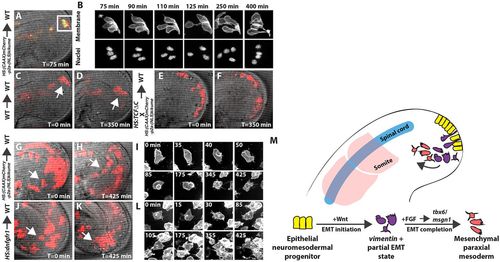Fig. 7
- ID
- ZDB-FIG-170516-44
- Publication
- Goto et al., 2017 - FGF and canonical Wnt signaling cooperate to induce paraxial mesoderm from tailbud neuromesodermal progenitors through regulation of a two-step EMT
- Other Figures
- All Figure Page
- Back to All Figure Page
|
Live imaging of tailbud EMT. (A-F) Transplanted HS:(CAAX)mCherry-p2a-(NLS)kikume cells were targeted to the NMP epithelium (A); the boxed region is shown in B. Time-lapse analysis shows that NMP epithelial cells undergo apical constriction and transition out of the epithelium but remain tethered to the epithelial layer by a stretched apical membrane (t=125 min; see also Movies 1 and 2; total of seven movies analyzed). The same embryo from A and B is shown in C and D at t=0 min (C) and t=350 min (D). Arrows (C,D) indicate cells that undergo the first EMT step over the course of the movie. Transplanted HS:TCFΔC cells heat shocked at the bud stage fail to leave the NMP epithelium (compare F with E; see Movie 3; total of four movies analyzed). (G-L) Cells that have left the NMP epithelium eventually migrate out of the tailbud into the PM territory (G,H, arrow), and produce extensive membrane protrusions during this process (I; see Movies 4 and 5). Cells lacking FGF signaling fail to directionally migrate out of the tailbud (J,K, arrow), but still exhibit extensive membrane protrusions (L; the cell in the center of panels is the same as that indicated by an arrow in J,K; see Movies 6 and 7; total of four movies analyzed). (M) Model for two-step EMT. In the zebrafish tailbud, Wnt initiates EMT in the sox2/ntla-positive NMP population through regulation of unknown target(s). This leads to movement into a transitional zone, where they express the EMT markers vimr1 and vimr2. Subsequently, FGF is required to terminate EMT and turn off early progenitor markers ntla/sox2 by promoting msgn1 and tbx16 expression. This results in exit from the tailbud and maturation of these cells to form the PM. |

